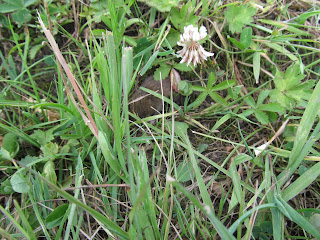Look hard enough and you should see a field mouse
(Click once to enlarge the pictures)
By our normal standards this has been something of a quiet week.
On Wednesday evening six riders completed a 24 mile course. I missed him last week on his first outing with us, but I was pleased to be able to exchange a few words this week with Rob from Malmesbury. We look forward to seeing Rob on a Saturday too, once he feels he's ready. If the speed with which he repaired his puncture is anything to go by, it won't be long.
There are a few towns locally which, should make great places for a coffee stop, but a lack of seating, absence of safe storage etc, has meant that we've always struggled to find somewhere suitable. Wootton Bassett, Cricklade and Cirencester are three that spring to mind.
As you'd expect, the MCCC Research Team never rests. It's a tough job, but someone has to do it. An initial visit by them to The Cake House, Bishop's Walk, Cirencester, was a success and so it became our destination on Saturday.
Eight riders mustered at our usual meeting place on Saturday morning. No one was in any particular hurry and so when Howard suggested that we all rode the outward leg of the longer course together, the motion was carried unanimously.
Just outside of Minety our peloton was brought to an abrupt halt by a small creature scurrying across the road. I foolishly thought it was possibly a shrew, but Paul, who clearly knows much more about these things than I do, identified it as a field mouse.
Having successfully negotiated a group of cyclists, the furry little fellow ran for cover and tried to hide in the clover. (Mention of the clover is just a lame attempt by me to regain some credibility).
The peloton waiting whilst I play at being Sir David Attenborough
We arrived at The Cake House and immediately laid claim to the vacant tables at the front. Seconds later we were joined by Simon Locke.
There was a good selection of reasonably priced cakes inside. I enjoyed my generous wedge of bread pudding. Unfortunately the pot of tea I shared with Mark was a disappointment. There was an overpowering taste of limescale and the unpleasant sensation of bits of limescale on the tongue.
Clarions soaking up the sun
The front of the cafe overlooks the busy public car park, but relaxing outside I couldn't help feeling a little smug watching the frustrated motorists completing endless laps searching for non-existent parking spaces.
I'd be happy to return to The Cake House, but they'll need to descale the kettle before I order any tea again!
Suitably refreshed, Howard suggested a slightly more adventurous route home via Daglingworth and again winning universal approval, we threaded our way through Cirencester.
Heading northwards towards the Gloucester Road
It's at this point that I have the immense pleasure of handing the blog over to Paul for a fascinating insight into Cirencester's rich Roman history.
Roman remains at Cirencester
Our ride on Saturday took us through prehistoric and Roman landscapes. North Wiltshire and Gloucestershire were the territory of the Iron Age kingdom of the Dobunni tribe, whose capital town was the hillfort at Bagendon, not but a few hundred yards from our home bound route through Daglingworth.
The Dobunni controlled much of what is today North Wiltshire and Gloucestershire, plus parts of Somerset, Warwickshire and Herefordshire. They appeared to be on pretty good terms with Rome before the Claudian invasion and may well have done a deal with Rome whereby they would not resist the invasion in return for retaining some level of their autonomy. Trouble was, the Catuvellauni, who led the resistance to the Roman invasion, were the dominant tribe, to whom the Dobunni, like many of the other southern British Tribes, paid homage and tribute. This made life tricky for the Dobunni but luck was with them as the Catuvellauni were broken and fled North before the Roman legions reached Dobunni territory. The Catuvellauni story is more interesting – even the subject of Shakespear's “Cybeline” - but I'll save that for when we ride our time machines through their territory.
Can't really leave the subject without mentioning Cirencester where we stopped at the “Cake Hole” to partake of refreshments. Once the Roman legions had mopped up in the South, they needed to build the infrastructure to support their advance North and for the general colonization of Britain. Cirencester was built on the crossroads of 3 major Roman roads: The Fosse, Akerman street and Ermin Street. The Cake Hole stands within the walls of the old Roman town of Corinium (Cirencester); these city walls encompassed an area of around 230 acres and you can still see parts of the old walls if you take a stroll into the church gardens. I can't remember the name of the church but it is the imposing one in the centre of town where all the buses stop. Corinium was second only in importance to London in Roman times and became the capital of Britania Prima following the partitioning of Britain by the emperor Diocletian. Many people think Britain was but a backwater of the Roman Empire; not so: there were 4 legions and a similar number of auxiliary troops stationed here numbering c 50,000 men to keep order. Many insurrections started in Britain and Diocletion decided to ….........but I'll spare you that.
Paul Hadley
Paul Hadley





Don't be afraid to complain about substandard refreshment. As a club with impeccable taste, we cannot and will not tolerate poor quality tea.
ReplyDeleteOh, I see! Paul, I thought it was the Dubonnet tribe.
ReplyDelete